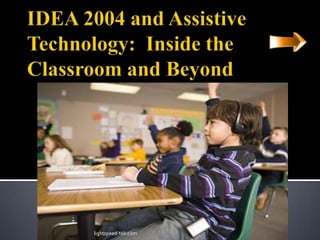
IDEA 2004 Empowers Parents to Advocate for Children with Learning Disabilities
- 2. 10 Tips: How to Use IDEA 2004 to Improve Your Child’s Special Education Steedman Esq., Wayne (2008, September 15) 10 Tips: How to Use IDEA 2004 to Improve Your Child’s Special Education. Wrightslaw.com. Retrieved August 6, 2010 from http://www.wrightslaw.com/idea/art/10.tips.steedman.htm Boosting Inclusion in After School Activities with AT and Supplemental Services National Center for Technology Innovation and Center for Implementing Technology in Education (2006) Boosting inclusion in After School Activities with AT and Supplemental Services. LD Online. Retrieved August 6, 2010 from http://www.ldonline.org/article/Boosting_Inclusion_in_After_School_Activities_with_AT_and_Supplemen tal_Services Goal Setting for Children with Learning Disabilities: Your Role is Important Brown, Dale S. (January 2008) Goal Setting for Children with Learning Disabilities: Your Role is Important. LD Online. Retrieved August 6, 2010 from http://www.ldonline.org/article/Goal_Setting_for_Children_with_Learning_Disabilities%3A_Your_Role_i s_Important
- 3. The Individuals with Disabilities Education Act of 2004 (IDEA 2004) expands the purposes of the original law to “ensure that all children with disabilities have available to them a free appropriate public education that emphasizes special education and related services designed to meet their unique needs and prepare them for further education, employment and independent living.” (Section 1400(d)(1)(A)) http://www.wrightslaw.com/idea/art/10.tips.steedman.htm
- 4. 1. Use the Findings and Purposes in IDEA 2004 to Establish a Higher Standard for a Free, Appropriate Public Education (FAPE). 2. Use IDEA 2004 to Obtain a Better Individualized Education Program (IEP). 3. Include Research Based Methodology in the IEP. 4. Ensure That Annual Goals are Comprehensive, Specific and Measurable. 5. Use New Evaluation Procedures to Monitor Academic Progress and Progress on IEP Goals. 6. Give Consent Only for Evaluations or Portions of the IEP to Which You Agree. 7. Insist that the Child’s Regular Education Teacher(s) Participate in IEP Meetings. 8. Avoid Three-Year IEPs Like the Plague. 9. Challenge Suspension or Expulsion if the Child’s Behavior was a Manifestation of the Disability, or if the Alternate Placement does Not Provide FAPE. 10. Avoid Due Process Hearings if Possible.
- 5. Parents must be familiar with IDEA 2004; they must know the law. Parents have control over their child’s Individual Education Program (IEP). Parents must do their homework by locating advocacy groups and other resources that can empower them. Parents must not assume that educators are doing what is best for their child, or that educators have a familiarity with their child’s disability.
- 6. IDEA 2004 provides for supplemental services and assistive technologies to students who receive special education services. Supplemental services may include assistance with extracurricular activities. Extracurricular activities provide valuable social benefits to those with special needs. Participation of students with learning differences in extracurricular activities is increasing. Educators must be vigilant in pinpointing special needs students’ interests in extracurricular activities, and make adaptive technologies available in those areas. Students’ interests rather than their needs should inform their selection of extracurricular activities, wherever possible.
- 7. Theater Some students with learning differences can use audible tapes or screen readers to memorize their lines. Music Music print notation can be converted into Braille for sight-impaired students. Modified instruments can be obtained at the district level if the local school cannot provide them. Book Clubs Alternative format books can be made available to blind or dyslexic students. Academic Games Students with difficulties with print materials can used readers or other assistive tools. Athletics There are organized events for wheelchair users such a basketball and cycling. Visually impaired students may participate in distance running with the help of a guide. Students with other disabilities may participate in the Special Olympics.
- 8. Many student-to-student bonds are made during extracurricular activities after school. If non-impaired students benefit from these activities, it stands to reason that students with learning differences do as well. Extracurricular activities boost confidence, foster leadership skills, and develop talents in learning impaired students just as they do the non-impaired.
- 9. Children need guidance in setting their goals and achieving them. Many learning impaired children have greater challenges in this area. Students with learning differences are more likely to become discouraged and lose confidence when they do no receive proper assistance, and fail to meet their goals. Goal-setting was listed by The Frostig Center as one of six essential attributes in making students with learning disabilities into successful adults.
- 10. Ask them about their dreams Encourage them to set goals related to their dreams Help them to work around their disabilities Teach perseverance by example Teach them to handle setbacks Inspire them to overcome their disabilities
- 11. Many children have difficulties in setting goals for their future. However, children with learning differences such as Attention Deficit Disorder may have difficulty scheduling homework, making good choices, self monitoring or even planning a weekend activity. Schools can set goals for them, such as good grades, but parents must be involved in their long-term focus and goal-setting.
- 12. There is a law. IDEA 2004 says that disabled children should be given the opportunity to meet the “challenging expectations that have been established for all children.” (Section 1400(c)(5)(E)) There are educators. They use provisions in the law to provide Assistive Technologies to students with learning differences both in the classroom and beyond. There are parents. They monitor both the educators and their learning-disabled children in order to tailor and manage their educations. There are students. They rely on the law, the educators, and their parents to navigate them into a future in which they can prosper. Alone, they accomplish little. But together, teachers, parents, and students can build a community of learning that is worthy of our highest ideals.